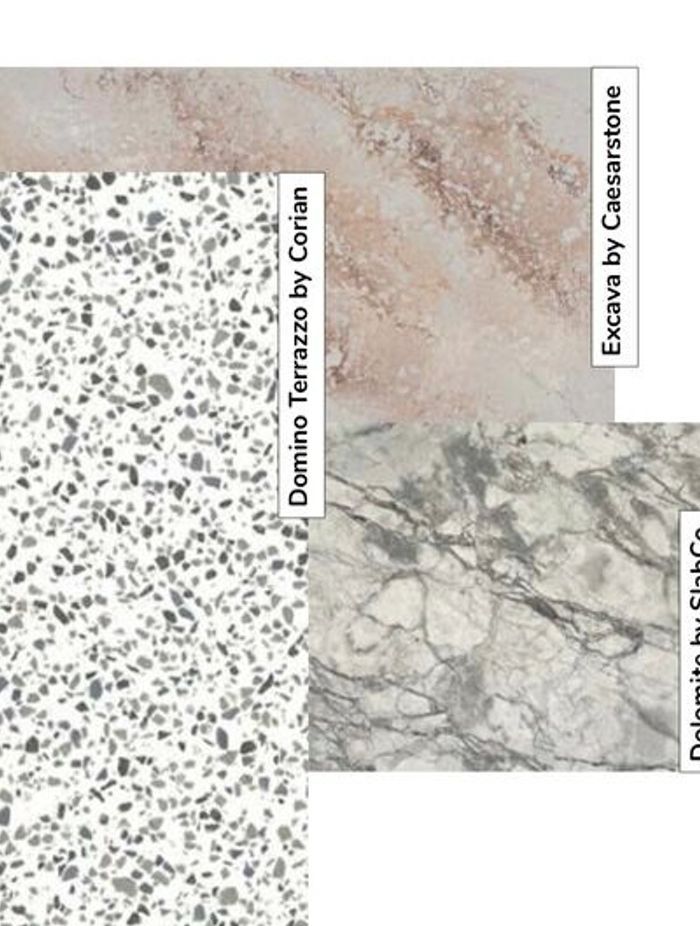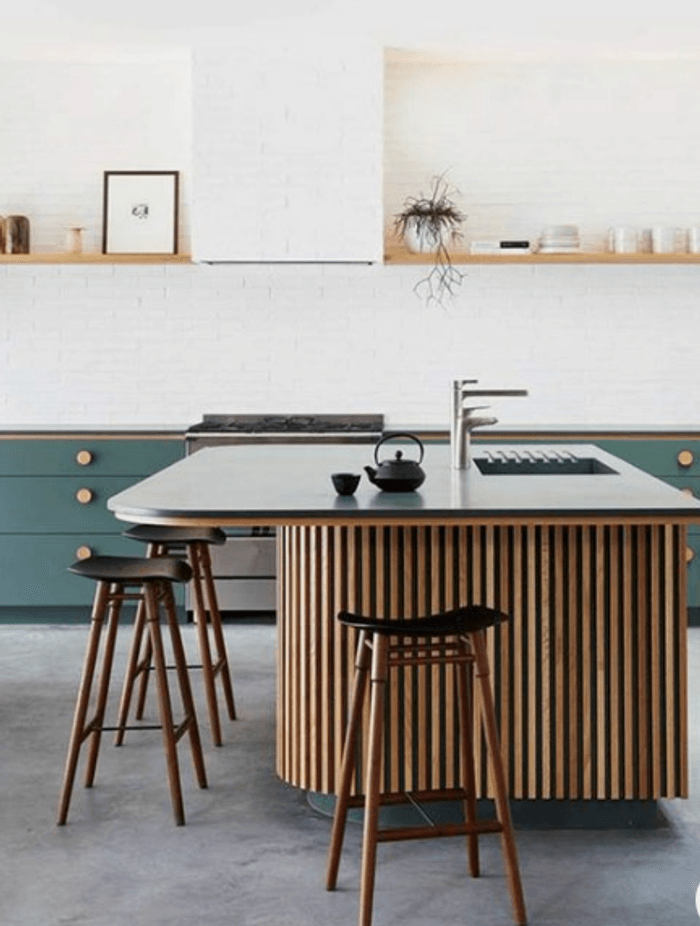Designers Guide to Kitchens - Haven Magazine


As we see the end of the trend of all white kitchens, we’re becoming braver with our choices - embracing colour, texture and interesting forms in our kitchen design. Maximum impact in the kitchen is hot right now! Using colour in your kitchen can create the mood for the entire home. If you want a neutral colour palette, stick with soft greens and earthy tones. If you want to embrace pastels, you can look towards a soft blue, mint green or even pale pink; or if you’re looking for a more sophisticated mood, black or dark blues are the colours for you. We’re seeing a lot of timber elements in kitchens which give a Scandinavian design feel - a strong trend that doesn’t seem to be easing. As designers we love things to line up, so straight lines are the dream! But we’re starting to see an ever-increasing number of beautiful kitchens with curves: curved island benches, curved corner cabinets.
BENCH TOPS
Stone continues to be the strongest trend in bench tops - and for good reason. The range of colours and textures available is overwhelming. Budget will probably play a big part in your decision, followed a close second by how much care you want to give your bench top. Natural stone comes in an amazing range of colours and textures and is a statement and work of natural art all rolled into one. However, because natural stone is more delicate and more porous, it takes more care. That means no leaving red wine rings on the bench overnight, as they may never come out.
Engineered stone, a mixture of natural and man-made products, is stronger and tougher, so easier to maintain. A new product on the market is Porcelain stoneware, made of a mixture of natural materials that have been pressed and taken through a firing process at temperatures of over 1200°C. The result is a benchtop that’s more resistant to wear and can withstand direct heat from even the hottest pans.


SPLASH BACKS
One trend we love is running the bench top up the wall as a splash back - creating a seamless look. Or, if you prefer a tile splash back, we’re seeing lots of amazing smaller tiles, called ‘kitkat’ or ‘finger tiles’. Subway tiles may not have done their dash just yet, with so many colours, styles and interesting configurations available. My current favourites are basket weave and herringbone.
LIGHTING
The kitchen is the hub of the home, so it’s important you have the lighting just right. In my opinion, lighting is one of the most important elements of a kitchen, and I always encourage clients to spend their money on an amazing feature lighting. Wall lights in the kitchen add warmth and style - when you’re next at a cool café, check out their wall lights and think about how you could bring this idea into your home. Over the bench a single large pendent at one end is striking. Make sure your light is the correct proportion for your home; if you have large ceilings your light will need to fill the void.
CABINETRY OPTIONS
There are four main options when it comes to what your cabinetry is made of, and each has different benefits.
Thermoform panels (Designertek) are made by wrapping vinyl film around the face and edges of a drawer, door or panel to provide a seamless, durable and moisture-resistant finish. Thermoform comes in a variety of colours, finishes and different door profiles, so you can easily have a shaker style style kitchen with this product.
Low pressure laminate (Malamine/Melteca) is a tough surface which is pressed onto wood-based panels to produce attractive, highly durable cabinetry or wall panels. You can choose double or single-sided, and select from a range of thicknesses, texture finishes and designs - from solid colours to wood grains. This is the most cost effective option.
Veneer is made when a thin layer of real wood is applied to wood-based panels. It can be used for interior cabinetry, furniture or wall panelling, and a wide range of wood types and designs are available. Veneer is a much more sustainable option than solid timber – for one cubic metre of solid wood you’ll get more than 900sqm of usable veneer.
Two Pot Lacquer, or 2PAC, is a hardened paint finish that can be applied to cupboard doors and drawers. Made from a mixture of resin (acrylic paint and melamine) and hardener, the result is a thick, smooth, hard finish. The benefit of two pot is that you have no edge tape and can choose any colour from the Resene range, and you can have any profile you wish.
STYLE OF KITCHEN
When deciding on the finish, you need to think about the style of kitchen you want to achieve. If you like a plain cabinet front then you can use a laminate finish, but if you’re looking for a moulded, tongue & groove or shaker style* kitchen, you’ll have to use either Designertek or a two pot lacquer finish.
KITCHEN ISLANDS
Kitchen Islands are getting more exciting these days, with the fronts becoming a place to play with materials. We’re seeing tiling on the front of the island or architectural mouldings, which create an interesting feature that ties in with the style of the wider kitchen.

HANDLES
Over recent years there’s been a strong trend of no handles in kitchens. But, while I’m a fan of keeping some cupboards clear of handles (especially overhead cupboards or small under bench units, where handles can look cumbersome), I do think handles on some cabinets and drawers look amazing. Choose the right handles and they’re like the jewellery of the kitchen - adding that little bit of wow factor.
If you don’t want to use many handles, try a few larger, long handles on tall pantries or integrated fridges. Or, if large handles aren’t your thing, consider a brass or timber knob.
(Top tip – not having handles won’t save you money, as you’ll pay more for push-to-open cupboards and drawers).

SINKS
Sinks are one thing I probably get the most questions about! Stainless steel is still the most popular and easy-care option, but if you’re looking for some wow factor, sinks come in a huge range of eye-catching colours.
If you have a black bench top I’d suggest going with a black sink. If you have a white bench top, an integrated white sink looks amazing, but unfortunately isn’t very practical. If wine or coffee is left in the sink it can stain - so if you have kids or don’t want the stress of maintenance, I’d say it’s best to avoid.


